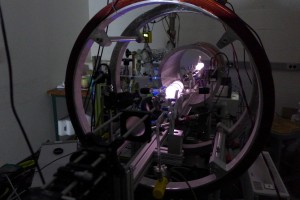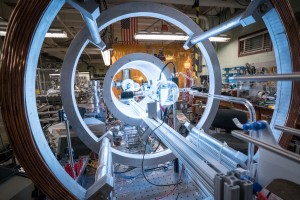Real Tech for Fighting Hollywood Ghosts
-
-
slice.mit.edu
- 3
Filed Under
Recommended

Growing up, nuclear physicist James Maxwell idolized scientists—and he had the movies to thank for it. “We used to play Ghostbusters on the playground. We had scientists as role models because of them,” he says. So it was particularly fortuitous for Maxwell—a former MIT postdoc and current researcher at the Thomas Jefferson National Accelerator Facility—when he was tapped to recreate some of his work for the new Ghostbusters movie. “It felt like I was struck by lightning” he says.

Ghostbusters began filming in Boston last summer, and, to get inspiration for props used in the film, the film crew reached out to Lindley Winslow, assistant professor of physics, for a tour of some of MIT’s labs. Winslow happened to work next to Maxwell and invited him to share his work with the filmmakers. “I was imagining that it was some local Boston indie filmmakers. Then I got there and turns out they were working for Ghostbusters,” he explains.
Maxwell says he showed off his helium-3 polarization lab. “It’s a fun-looking apparatus that’s got some big magnets, glass cells and tubes, lasers and light-up plasma,” he says. Ghostbusters director Paul Feig agreed that the device looked fun. Maxwell says, “They took pictures of it along with other things and Paul Feig saw my apparatus and pointed at it and said, ‘I want that!’” Feig not only the desired apparatus for the film, but Maxwell as well, inviting him to the set to replicate his device. The replica of Maxwell’s apparatus was destined for a starring role in the movie, that of the proton pack—the large backpack-style weapon used in the film series to weaken ghosts.
Building a replica device on set provided a unique challenge for Maxwell. “I thought ‘How do I build these things that look they work but actually don’t?’” he says. Maxwell says the technology isn’t there yet for a working proton pack—

and the existence of ghosts is up for debate—but he created the prototype on the supposition that these things are possible. “I had to think about how it might actually work and label each part, so I came up with a semi-feasible way for getting a proton pack to work on your back,” he says.
Though technology hasn’t caught up to his proton pack design, Maxwell says whenever he talks about the device, it’s an opportunity. “Each time someone asks about it, it’s an opportunity to educate someone,” he says, explaining the main technology behind the proton pack in a particle accelerator, which is a very real thing.
Maxwell, who left MIT at the end of last summer, says the work with Ghostbusters was a fitting end to his time at the Institute, “I can’t believe I was randomly chosen out of all the cool-looking things at MIT,” he says. And as for fears that all his hard work might end up on the cutting room floor, Maxwell isn’t worried. “It’s already in the trailers!” he says. Ghostbusters, along with Maxwell’s proton pack, is in theaters this July.







Comments
mkt42
Tue, 05/10/2016 10:27am
Cool story, but how can it fail to remark upon a physicist being named James Maxwell? That's like being an economist named John Keynes, or a statistician named R. Fisher.
Nicole Morell
Wed, 05/11/2016 1:14pm
Excellent point! I'll have to follow up with James and see how often people remark upon that fact. Thanks for the comment!
Sally Maxwell
Tue, 05/10/2016 5:38pm
Incredible, isn't it? His parents had no idea! It was a family name.